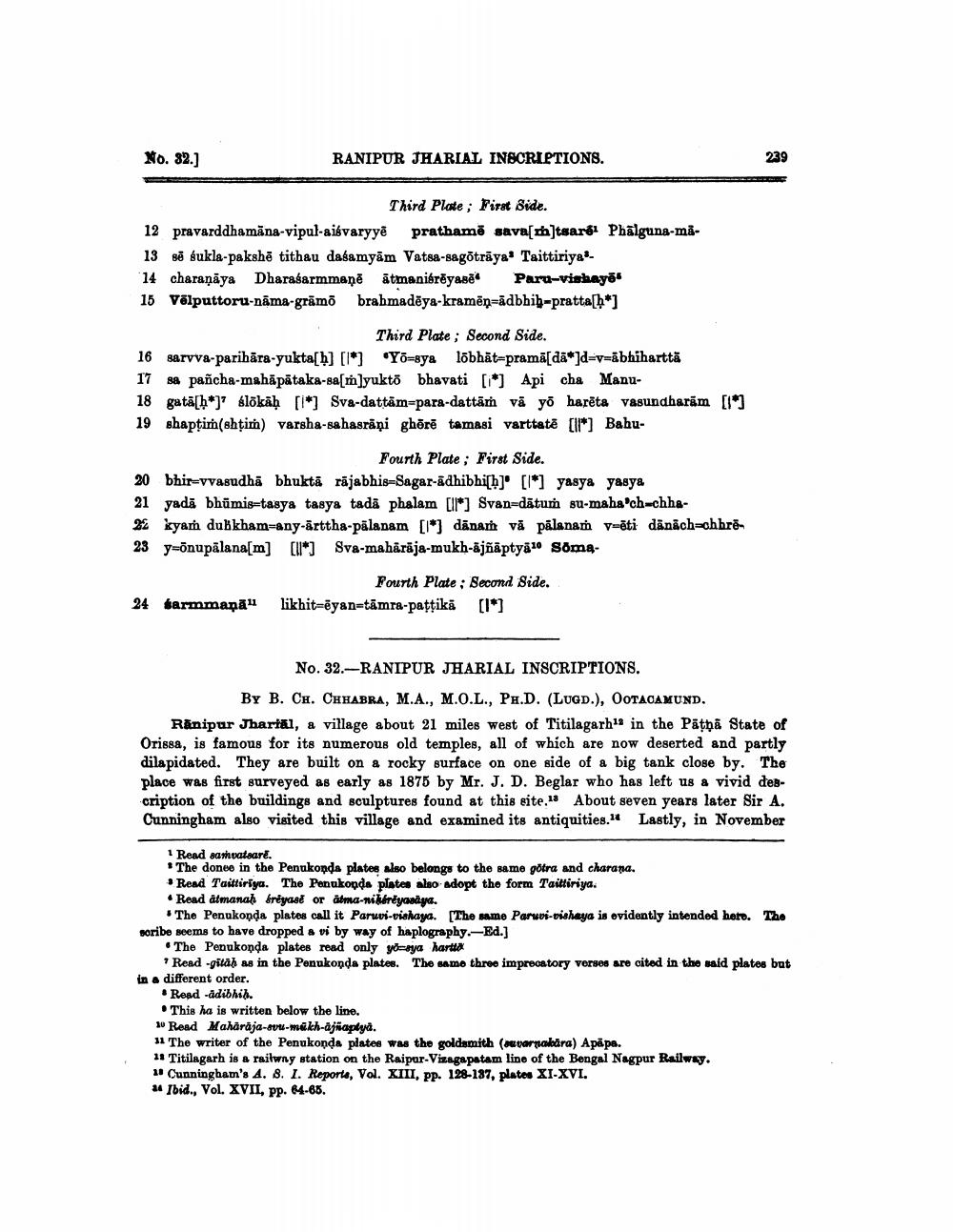________________
No. 32.]
RANIPUR JHARIAL INSCRIPTIONS.
Third Plate; First Side.
12 pravarddhamana-vipul-aiśvaryye prathame sava[m]tsaré1 Phalguna-ma
13 se sukla-pakshe tithau dasamyam Vatsa-sagōtraya Taittiriya"
Paru-vishaye
14 charaṇaya Dharaśarmmanē ātmanisreyasē 15 Vēlputtoru-nama-grāmō
brahmadeya-kramen-adbhih-pratta[*]
Third Plate; Second Side.
16 sarvva-parihara-yukta[b] [*] Yo-sya lobhat-pesmā[dä*]d-v-ābhiharttä sa pañcha-mahāpātaka-sa[m]yuktō bhavati [*] Api cha Manu
17
18 gata[*] ślōkāḥ [*] Sva-dattam-para-dattam va yō harēta vasundharam [*]
19 shapṭim(shtim) varsha-sahasraņi ghērē tamasi varttate [*] Bahu
Fourth Plate; First Side.
20 bhir-vvasudha bhuktā rājabhis-Sagar-adhibhi[h] [*] yasya yasya
21 yada bhumis-tasya tasya tada phalam [*] Svan-dātum su-maha'ch-chha
22 kyam dukkham-any-arttha-palanam [*] danaṁ vā pālanaṁ v-ēti dānāch-chhre23 y-önupälana[m] [*] Sva-mahārāja-mukh-äjääptyä" Soma
Fourth Plate; Second Side. [*]
24 sarmmaņa" likhit-eyan-tamra-paṭṭikā
239
No. 32. RANIPUR JHARIAL INSCRIPTIONS.
BY B. CH. CHHABRA, M.A., M.O.L., PH.D. (LUGD.), OOTACAMUND.
Ränipur Jharial, a village about 21 miles west of Titilagarh1 in the Päṭhā State of Orissa, is famous for its numerous old temples, all of which are now deserted and partly dilapidated. They are built on a rocky surface on one side of a big tank close by. The place was first surveyed as early as 1875 by Mr. J. D. Beglar who has left us a vivid description of the buildings and sculptures found at this site.13 About seven years later Sir A. Cunningham also visited this village and examined its antiquities." Lastly, in November
1 Read samvatsare.
The donee in the Penukonda plates also belongs to the same götra and charana.
Read Taittiriya. The Penukonda plates also adopt the form Taittiriya.
Read almanah breyase or atma-nikéryasaya.
The Penukonda plates call it Paruvi-vishaya. [The same Paruvi-vishaya is evidently intended here. The scribe seems to have dropped a vi by way of haplography.-Ed.]
The Penukonda plates read only yo sya hartto
*Read -gitāḥ as in the Penukonda plates. The same three imprecatory verses are cited in the said plates but in a different order.
Read -adibhib.
This ha is written below the line.
10 Read Maharaja-svu-mukh-äjñaplyä.
11 The writer of the Penukonda plates was the goldsmith (savarnakāra) Apāpa.
13 Titilagarh is a railway station on the Raipur-Vizagapatam line of the Bengal Nagpur Railway.
1 Cunningham's A. 8. I. Reports, Vol. XIII, pp. 128-137, plates XI-XVI.
14 Ibid., Vol. XVII, pp. 64-65.




